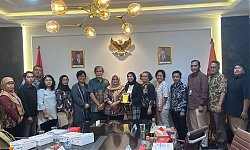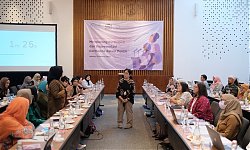"There is no best electoral system, there is only a suitable electoral system," more or less so many observers of the electoral system quoted Andrew Reynolds' conclusion. This international election scholar is of the opinion that the suitability of a country's choice of electoral system depends on context and needs. The obsession with finding the perfect or best electoral system tends to be avoided.
If we interpret "suitable" with the phrase "which significantly increases women's representation", is there an electoral system like this? Of course, looking for this match from the need to improve state protection/services for women as citizens. There is an opinion that the state is not good or bad in protecting and serving women's rights, one of which is because the parliament quantitatively does not represent 50 percent of its citizens.
The International Institute for Democracy and Electoral Assistance (IDEA) on its website has mapped out the choice of electoral system and the percentage of women's representation in parliament from many countries. This list does not include countries whose achievements are due to the application of affirmations in the form of reserved seats.
In total there are 57 countries that are included in the list of users of women's affirmations through the electoral system. Bolivia has the highest percentage of women's representation with 53.08 percent of the 130 seats in the House of Representatives. The lowest was the Solomon Islands, with 6.1 percent of 49 seats.
And, the average percentage of women's representation from these 57 countries is 27 percent. The rankings in this paper only include the House of Representatives (DPR) without a senate because not all countries implement a bicameral parliament.
So far, the figure of 30 percent is considered the minimum number of women's representation that is representative in number. We know, to pass a law it takes 50% + 1 council members. At least 30 percent of women from the total seats in the DPR can maintain and influence the women's agenda of a law.
If we refer to the list of 57 countries, affirmation of women through elections contained in the law and even the constitution, does not guarantee the achievement of the minimum percentage. The reasons are many, one of which is the incompatibility of the choice of the electoral system with the political context and the various system variables.
Proportional System
There are only 18 countries that achieve 30 percent more representation of women. This means that only 31.6 percent are suitable for choosing the electoral system and its system variables for achieving the minimum number of women in the DPR.
Referring to the four divisions of the International IDEA electoral system, there are only three choices of electoral systems that make 18 countries achieve 30 percent more women's representation. The first is the plurality/majority system. Second, the proportional representation system (PR). Third, the mixed system (mixed). No other electoral system achieves more than 30 percent of women's representation, whether the single non-transferable vote (SNTV), limited vote (LV), or the borda count (BC) variants.
In general, a plurality/majority system is the opposite of a proportional system. The plurality/majority system, commonly known as the district system, as applied in the United States with the plurality/first past the post (FPTP) variant, is an electoral system in the form of 1 seat competition for each electoral district (dapil). While the proportional system is an election system in the form of competition in which the allocation of seats in each electoral district is more than 1 in proportion to the total population. Mixed system, combining the form of a plurality/majority system and a proportional system in one parliamentary election. Then, the other system is a system whose form cannot be included in the other three systems.
Table 1. Countries’ House of Representative with Achievement in Women's Representation and Choice of Electoral System
|
Rank |
Country |
Women’s Representation |
House of Representative Seats |
Electoral System |
|
1 |
Bolivia |
53.08% |
130 |
Mixed |
|
2 |
Mexico |
48.20% |
500 |
Mixed |
|
3 |
Nicaragua |
47.25% |
91 |
List PR |
|
4 |
Costa Rica |
45.61% |
57 |
List PR |
|
5 |
Spain |
44.00% |
350 |
List PR |
|
6 |
Senegal |
43.03% |
165 |
Mixed |
|
7 |
Argentina |
40.86% |
257 |
List PR |
|
8 |
Belgium |
40.67% |
150 |
List PR |
|
9 |
North Macedonia |
40.00% |
120 |
List PR |
|
10 |
Portugal |
40.00% |
230 |
List PR |
|
11 |
France |
39.51% |
577 |
Plurality/Majority |
|
12 |
Ecuador |
39.42% |
137 |
List PR |
|
13 |
Timor-Leste |
38.46% |
65 |
List PR |
|
14 |
Serbia |
37.65% |
247 |
List PR |
|
15 |
Italy |
35.71% |
630 |
Mixed |
|
16 |
El Salvador |
33.33% |
84 |
List PR |
|
17 |
Uzbekistan |
32.00% |
150 |
Plurality/Majority |
|
18 |
San Marino |
31.67% |
60 |
List PR |
From that list, there are only two countries that choose a plurality/majority electoral system, namely France and Uzbekistan. Then, there are four countries that choose a mixed electoral system, namely Bolivia, Mexico, Senegal, and Italy. The remaining 12 countries chose the proportional electoral system (PR List).
This fact corresponds to the consequential nature of the electoral system. The plurality/majority electoral system has consequences that tend to exclude political plurality (minority political parties, marginalized groups, women, and others). On the other hand, proportional electoral systems tend to accept pluralism, so this system is suitable for the needs of increasing women's representation.
The nature of the consequences of a proportional electoral system that is more-friendly to pluralism seems to have become a global awareness. International IDEA concludes, from 1990 to 2010, many countries tweaked electoral system variants such as electoral district size to be more representative.
There are at least 27 countries that have significantly changed their electoral system. The trend of changing the electoral system of these countries is from a plurality/majority to a proportional electoral system. It seems that the representative nature of the election results is more needed to be strengthened than the nature of its effectiveness.
Open/Closed List Proportional?
Then, of all the countries that chose the proportional electoral system, which variant of the system was chosen the most from countries that achieved women's representation of more than 30 percent? Is the system proportional to the open list variant or the closed list variant?
Table 2. Comparison of the Percentage of Women's Representation in a Country with a Closed/Open List Variant of Proportional Electoral System
|
Rank |
Country |
Women’s Representation |
Election System |
Varian |
|
3 |
Nicaragua |
47.25% |
List PR |
Closed List |
|
4 |
Costa Rica |
45.61% |
List PR |
Closed List |
|
5 |
Spain |
44.00% |
List PR |
Closed List |
|
7 |
Argentina |
40.86% |
List PR |
Closed List |
|
8 |
Belgium |
40.67% |
List PR |
Open List |
|
9 |
North Macedonia |
40.00% |
List PR |
Closed List |
|
10 |
Portugal |
40.00% |
List PR |
Closed List |
|
12 |
Ecuador |
39.42% |
List PR |
Open List |
|
13 |
Timor-Leste |
38.46% |
List PR |
Closed List |
|
14 |
Serbia |
37.65% |
List PR |
Closed List |
|
16 |
El Salvador |
33.33% |
List PR |
Open List |
|
18 |
San Marino |
31.67% |
List PR |
Open List |
Of the 12 countries that chose the proportional electoral system, there were four countries that chose the open list variant to achieve women's representation of more than 30 percent, namely: Belgium, Ecuador, El Salvador, and San Marino. The remaining eight countries chose the closed-list variant, namely: Nicaragua, Costa Rica, Spain, Argentina, North Macedonia, Portugal, Timor-Leste, and Serbia.
What needs to be realized, from the achievement of the percentage of women's representation through the electoral system and its variants, includes other aspects. There are four countries that implement women's affirmation through constitutional guarantees, namely: Mexico, Argentina, France, Ecuador, Serbia, and Italy.
Then, there are nine countries that have good conditions for democratizing political party institutions. The freedom to form political parties and their participation in elections makes these countries have a competitive climate for political party contestation, including in terms of women's affirmations. Many political parties in this country take the initiative to add affirmations to women's internal political parties, either at the stage of education/cadreization, nomination, campaign, or election. These countries are Bolivia, Mexico, Nicaragua, Costa Rica, Spain, Argentina, France, Italy and El Salvador. []
USEP HASAN SADIKIN











